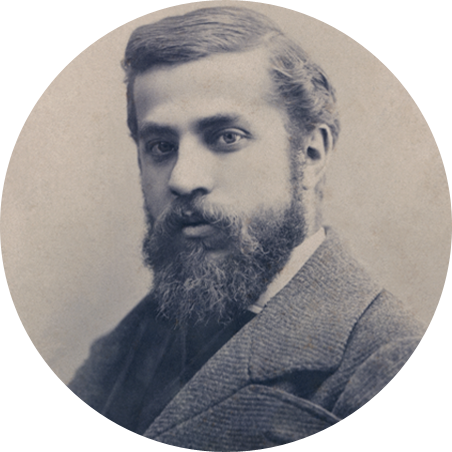
Antoni Gaudí i Cornet
25 June 1852 - 10 June 1926
In Catalonia, at the end of the 19th century, the social and political movement of the Renaixença or Rebirth was manifested from the artistic standpoint through Modernisme, a current which, in the Europe of the times, went by several different names: Art Nouveau (France and Belgium), Jugendstil (Germany and the Nordic countries), Modern Style (Anglo-Saxon countries), Sezession (Austria), Liberty (Italy), etc. Modernisme was opposed to the conservatism of the bourgeoisie and sought to change society through art and to regenerate the “uncultured” masses. It also had an aesthetic component in which art acted as the refuge and religion of artists. Paradoxically, the movement handed down to us some magnificent works which were commissioned precisely by an optimistic enterprising Catalan bourgeoisie.
The Catalan architects, painters, poster artists and craftsmen of the times usually worked in collaboration with each other, allowing a unique synergy which, in the short period of the turn of the century, thoroughly bedazzled society. One of the foremost artists of this period, which extends from about 1885 to 1915, was unquestionably Antoni Gaudí. This architect is deserving of special recognition for his original creative work. He was a unique figure whose production has been situated within the framework of Modernisme although, on looking at it more closely, one finds that it reaches far beyond the bounds of that artistic movement.
Gaudí was a master at using tradition-based building techniques which produced, in his hands, architectures that were far ahead of his time. The universe of Gaudí encompasses much more than just the Sagrada Família and La Pedrera. Over the course of his prolific career, he built religious buildings, residential developments and private homes, in addition to doing a number of works on a smaller scale and a multitude of designs and projects which never saw the light or which he left to be completed by his collaborators. Gaudí was a total architect and a multifaceted figure who, one century later, continues to capture the whole world’s interest.
-
1852
Antoni, the fourth and last child of Francesc Gaudí i Serra and Antònia Cornet i Bertran, was born on 25th June and baptized the next day at the parish church of Reus, the city where his family lived and where his father worked as a coppersmith. Credit-worthy local references and some oral statements by Gaudí himself set his birthplace in the municipality of Riudoms, specifically at the country house Mas de la Calderera (the “House of the Coppersmith’s Wife”, a name alluding to his grandfather’s trade). This was a modest family property located quite close to Reus where Antoni spent much of his childhood.
-
1863 - 1868
He attends in Reus the elementary school of the schoolmaster Berenguer, the father of his future assistant Francesc Berenguer i Mestres, going on to do his secondary studies at the Piarist School.
-
1867 - 1869
Gaudí does some drawings for the school magazine El Arlequín in Reus, together with his companions Josep Ribera and Eduard Toda, with whom he also drafted a youthful proposal for the restoration of the Monastery of Poblet. Years later Eduard Toda would come to be actively involved in the monastery’s restoration.
-
1869
Antoni Gaudí moves to Barcelona to complete his secondary studies, following the steps of his brother Francesc, who was by then studying medicine. Antoni subsequently enrols in the Faculty of Sciences of the University of Barcelona to prepare himself for the University School of Architecture.
-
1876
Death of Antoni’s mother and of his brother Francesc.
-
1876 - 1878
While studying architecture, Gaudí works as a draughtsman for the architect Francesc de Paula del Villar i Lozano on the project for the new apse of the church at the Monastery of Montserrat, which would house the camarín chapel of the image of Our Lady of Montserrat. He also works with the master builder Josep Fontserè on projects in Barcelona’s Ciutadella Park, and as a draughtsman with Leandre Serrallach, an architect and teacher at the School of Architecture.
-
1878
Gaudí obtains his degree as an architect on 15th March. “They say I’m an architect now”, he comments ironically to the sculptor Llorenç Matamala at the Puntí workshop, where he was having his desk built. He opens his studio at Carrer de la Cera, next to that workshop, and he begins to receive his first commissions: the design of a street kiosk combining a public urinal with a flower stall, for Enric Girossi, and the project for the electric lighting of the city’s Seaside Wall.
-
1878
He designs a glazed display window for the glove maker Comella, to be used at the Universal Exposition of Paris. In the course of its construction, he meets Eusebi Güell i Bacigalupi, who would come to be his foremost client in time. Gaudí does drawings for an allegorical cavalcade in the town of Vallfogona de Riucorb, in honour of the priest and poet Rev. Vincent Garcia.
-
1878
In collaboration with his former fellow student Emili Cabanyes, he designs a group of dwellings for workers of the Mataró Workers Cooperative. Gaudí, who was a friend of the cooperative’s director, Salvador Pagès, had previously worked for this organisation as a student in 1874 and he would continue to do so until 1888, cooperating on various projects including its bleaching building, now called the “Nau Gaudí”.
-
1879
Gaudí participates actively in the trips organised by the Architects Association of Catalonia and the Catalanist Association of Scientific Excursions. His sister Rosa dies. As a result, Gaudí takes charge of his niece Rosita Egea and of his father Francesc, who moves to Barcelona.
-
1881 - 1890
Once graduated, Gaudí starts to work with the prominent architect Joan Martorell on the façade of the Cathedral of Barcelona, on the Church of the Salesians, on the Jesuit Church at Carrer de Casp in Barcelona, and on the design of the church for the Benedictine Monastery of Villaricos in Almería province.
-
1880 - 1882
Commission for the furnishing of the pantheon-chapel of the family of the Marquis of Comillas, which was being built by the architect Joan Martorell. Gaudí also builds a pavilion in the palace gardens for the visit of King Alfonso XII. This structure was subsequently dismantled and temporarily installed in the gardens of the Güell Estate.
-
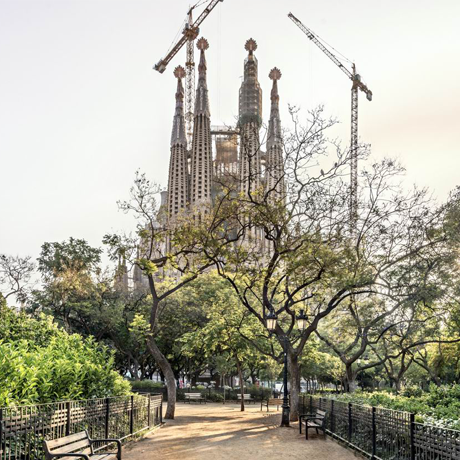
1882
On 19th March, the feast of St. Joseph, the cornerstone of the Sagrada Família, a church designed by the architect Francesc de Paula del Villar, was laid. According to this project’s promoter, J. M. Bocabella, the structure was to be in the Neoclassical style, drawing its inspiration from the Italian Church of Loreto.
-
1883
Gaudí does designs, which never come to be built, of a hunting lodge for Eusebi Güell on his property in El Garraf, and of a retable for the parish church of Alella.
-
1883 - 1885
Gaudí builds a pavilion popularly known as “El Capricho” (“The Folly”) adjacent to the Sobrellano Palace in Comillas for Máximo Díaz de Quijano, a friend and acquaintance of the Güell and López families. Since the site of this project was far from Barcelona, Gaudí entrusts its management to the architect Cristóbal Cascante, who also works with the Catalan architects Joan Martorell and Lluís Domènech i Montaner on important projects for the Marquis of Comillas.
-
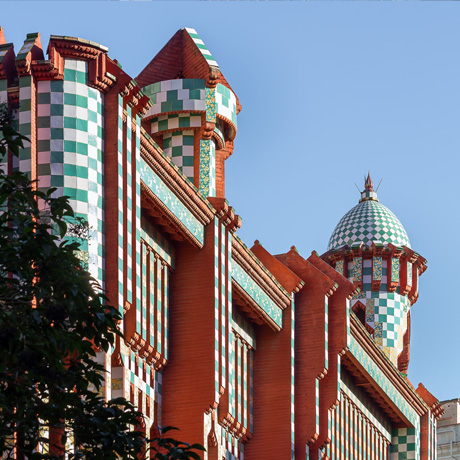
1883 - 1888
The architect builds his first structure in Barcelona: the Vicens House. To help out on this project, Francesc Berenguer i Mestres, a student in his first year of architecture at the Provincial School of Barcelona, goes to work at Gaudí’s studio, becoming one of his foremost assistants.
-
1884
Villar resigns as architect of the church of the Sagrada Família due to technical disagreements with the project’s promoter. The influence of Joan Martorell is decisive in achieving the appointment of Gaudí as Villar’s successor despite the young architect’s religious beliefs.
-
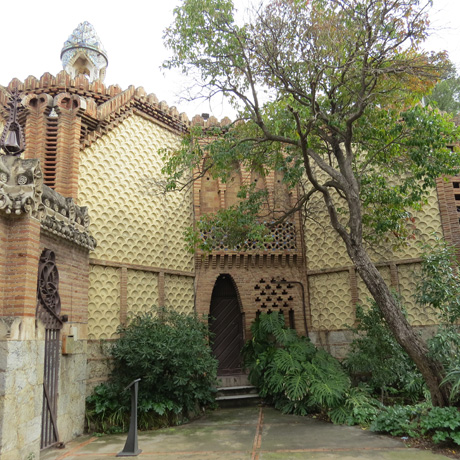
1884 - 1887
Gaudí designs and builds his first project for Eusebi Güell: the wall and entrance pavilions for Güell’s property in Les Corts de Sarrià, together with some small ornamentation works in the interior of the property.
-
1884 - 1889
The crypt of the church of the Sagrada Família is completed according to Villar’s design, which Gaudí reforms in part.
-
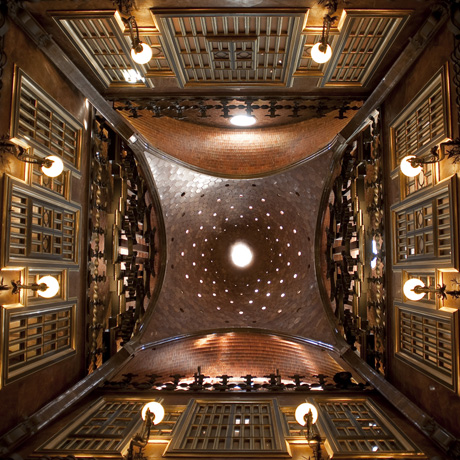
1886 - 1889
The architect builds the Güell Palace, a singular urban residence at Carrer Nou de la Rambla, which was first conceived as an expansion of the Güell family’s mansion at La Rambla.
-
1887
Barcelona City Council commissions Gaudí to do a renovation of the Hall of the Hundred, which never comes to be carried out.
-
1887
Gaudí refurbishes an existing building, adapting it to serve as the pavilion of the Transatlantic Company of the Marquis of Comillas for the Universal Exposition of Barcelona. Joan Baptista Grau i Vallespinós, the bishop of Astorga and a native of Reus, commissions Gaudí to rebuild his episcopal palace, which had been destroyed by a fire. The bishop dies in 1893 and Gaudí leaves the project due to disagreements with the bishop’s successor.
-
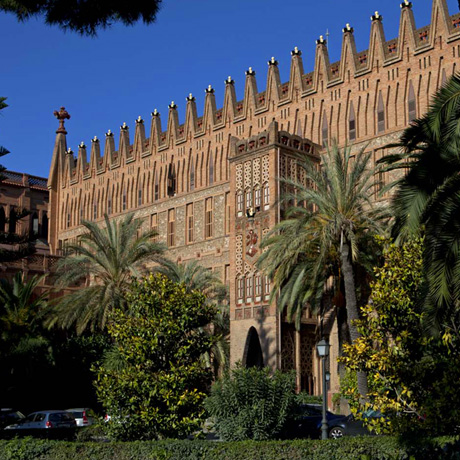
1889 - 1890
The architect builds the Convent of the Teresians or Discalced Carmelites, a project which had been started by Joan B. Pons i Trabal one year earlier. Gaudí takes charge of the works and substantially reforms the project from the existing foundations on up.
-
1891 - 1894
In León, Gaudí builds the Fernández y Andrés House, popularly known as the “Casa de los Botines”, a free-standing edifice for commercial and residential use, for two of Eusebi Güell’s business associates.
-
1892 - 1893
Project of the Franciscan Missions in Tangier, sponsored by the second Marquis of Comillas, Claudio López Bru.
-
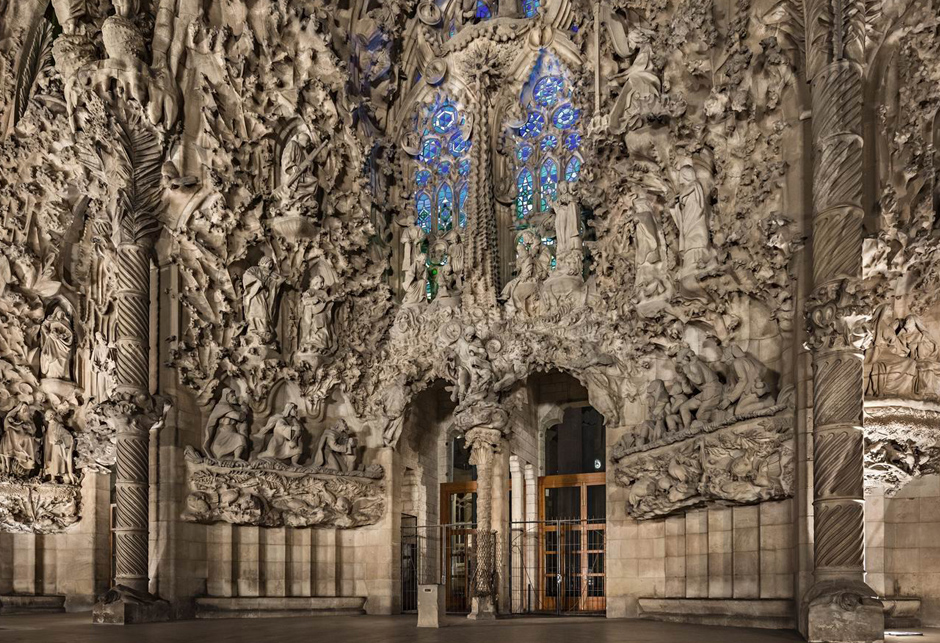
1894
Gaudí finishes the crypt and the apse of the church of the Sagrada Família. Since the project was receiving substantial funding, Gaudí proposes the building of the Nativity façade to the Construction Board.
-
1894
The architect contracts a serious illness due to his severe Lenten fasting, surviving thanks to the pressure and care of his friends and of the Bishop Torres i Bages.
-
1895 - 1897
Francesc Berenguer i Mestres builds the Güell wine cellars in El Garraf, a structure that has been attributed to Gaudí. It was common for Gaudí to pass on commissions to Berenguer, subsequently signing them in his own name for official purposes, as occurred with the Damià Mateu House in the town of Llinars del Vallès.
-
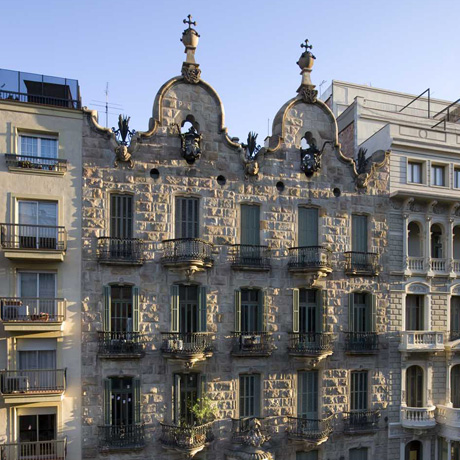
1898 - 1899
Design and construction of the Calvet House in the “Eixample house” style at Barcelona’s Carrer de Casp. Barcelona City Council named it the Best New Building of the Year in 1900.
-
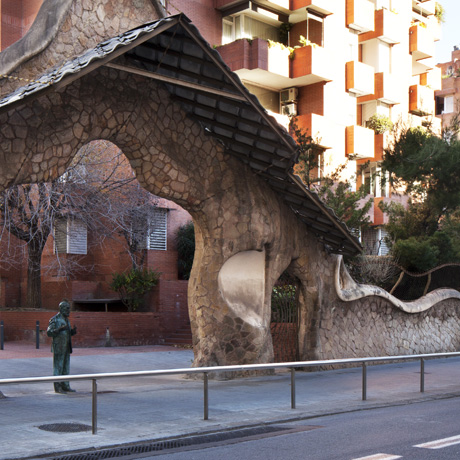
1901 - 1902
The industrialist Hermenegildo Miralles, a friend of Gaudí, commissions the architect to design his residence on a property on the outskirts of the city, close to the Güell Estate. Only the entrance gate and part of the property’s enclosing wall (which has been partially preserved) comes to be built.
-
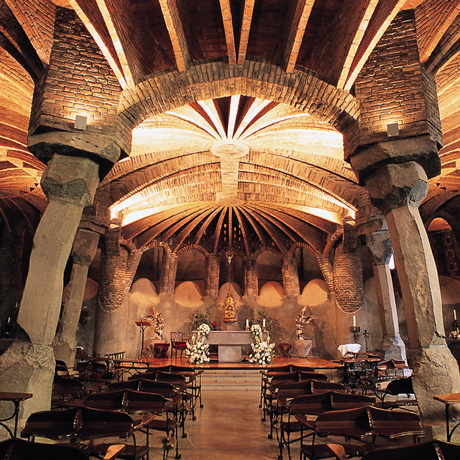
1899 - 1915
Güell commissions Gaudí to build the church for his factory colony in the town of Santa Coloma de Cervelló. The architect has the collaboration of the engineer Eduardo Goetz and of the architect Joan Rubió i Bellver. Eusebi Güell’s death in 1918 puts an end to the works and the crypt and its entrance atrium are all that come to be completed.
-
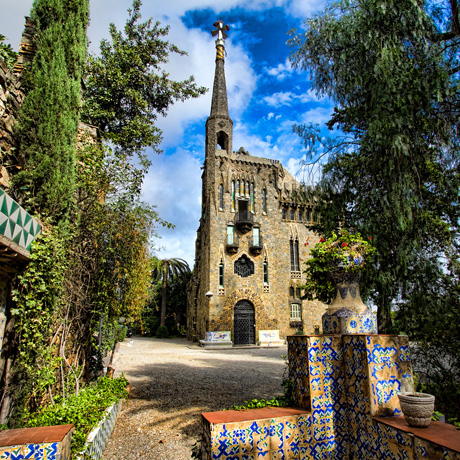
1900 - 1909
The architect builds Bellesguard, a house for Maria Sagués, the widow of Jaume Figueras, adjacent to the ruins of the one-time residence of King Martin “the Human”, which Gaudí preserves by diverting the course of the entrance way along a new viaduct. He is assisted by his collaborators Joan Rubió and Domènec Sugrañes.
-
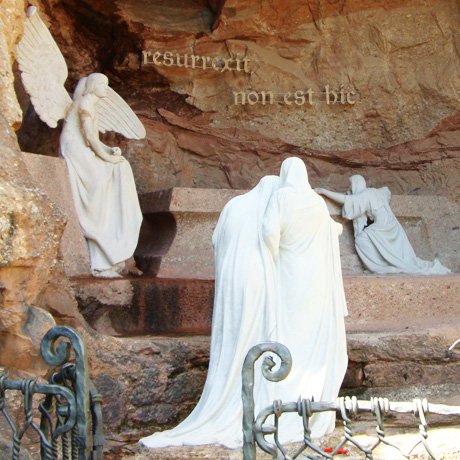
1900 - 1916
The Spiritual League of Our Lady of Montserrat commissions Gaudí to design and build the First Mystery of Glory of the Rosary, a project which is completed after several interruptions by his assistant Joan Rubió.
-
1902 - 1910
Bishop Campins calls on Gaudí to commission him the renovation of the Cathedral of Majorca with a view to adapting it to the new liturgy. The architect works with Joan Rubió i Bellver and Josep Maria Jujol, his devoted collaborators, but after the bishop’s death he finally leaves the project due to disagreements with the cathedral chapter, which does not approve of his work.
-
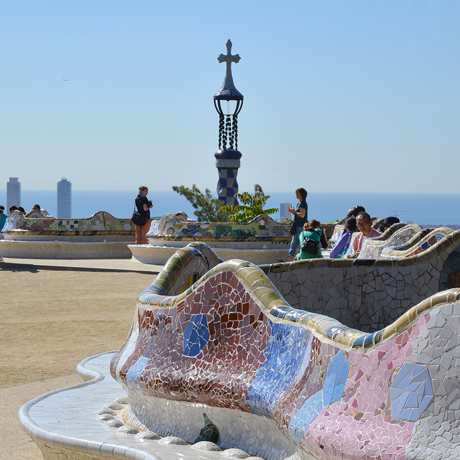
1902 - 1904
Eusebi Güell purchases the Can Muntaner de Dalt property, popularly known as “La Muntanya Pelada” or Bald Mountain, commissioning Gaudí to design a garden city development there. This commercial enterprise proved to be a failure and years later the City Council bought the property for a symbolic price. This property later became the Park Güell.
-
1905
Eusebi Güell commissions Francesc Berenguer i Mestres to build a model home at Park Güell which is subsequently purchased by Gaudí. The architect lives here with his niece and his father until the latter’s death.
-
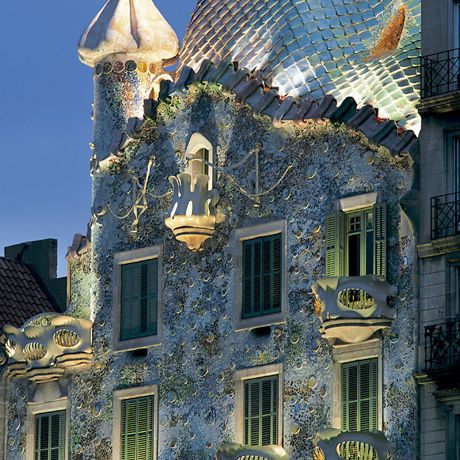
1904 - 1906
Josep Batlló commissions Gaudí to remodel the building constructed in 1875 by the architect Emili Sala i Cortés at Passeig de Gràcia, 43, in Barcelona. Gaudí radically renovates the front and rear façades, the roof, the staircase and the interiors of the ground, main and attic floors.
-
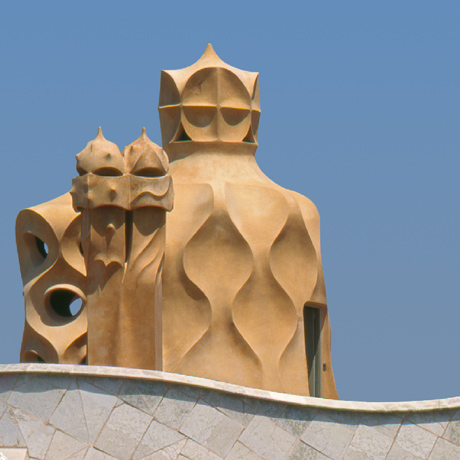
1906 - 1910
Impressed by the success of the Batlló House, Pere Milà and Roser Segimon commission Gaudí to design an imposing apartment building at Passeig de Gràcia, 92, on the corner of Carrer de Provença, where they will install their residence. This, Gaudí’s last civil work – known as “La Pedrera” (The Stone Quarry) –, proves to be polemical and misunderstood. Gaudí finally comes to bring a lawsuit against the owner Roser Segimon.
-
1909
On the grounds of the church of the Sagrada Família, the architect builds a small but remarkable building conceived as a school. It features an innovative geometry based on traditional brick masonry building techniques.
-
1910
Gaudí travels to Vic to recover from an anaemia. During his stay there he designs some street lights which will later be built by his collaborators Canaleta and Jujol.
-
1911
The architect stays in Puigcerdà with his friend, Dr. Santaló, to cure himself of brucellosis. He writes his last will there.
-
1925
The first spire of the Sagrada Família’s Nativity façade, the St. Barnabas Tower, is finished. It is the only spire which Gaudí comes to see completed in his lifetime.
-
1926
On 7 June the architect is struck by a passing tram near Plaça de Tetuan when walking to the Church of St. Philip Neri after his day’s work on the Sagrada Família, where he lived humbly in his workshop. Gaudí dies in the hospital on 10 June and his funeral is held two days later in the Cathedral. A multitude of people accompany his remains along the streets of Barcelona from the Cathedral to the church of the Sagrada Família, where he is buried in the crypt.
-
10th of June 1926